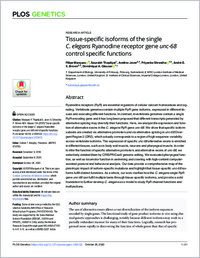Tissue-specific isoforms of the single C. elegans Ryanodine receptor gene unc-68 control specific functions
- Marques, Filipe Department of Biology, University of Fribourg, Fribourg, Switzerland
- Thapliyal, Saurabh Department of Biology, University of Fribourg, Fribourg, Switzerland
- Javer, Avelino MRC London Institute of Medical Sciences, London, United Kingdom - Institute of Clinical Sciences, Imperial College London, London, United Kingdom
- Shrestha, Priyanka MRC London Institute of Medical Sciences, London, United Kingdom - Institute of Clinical Sciences, Imperial College London, London, United Kingdom
- Brown, André E. X. MRC London Institute of Medical Sciences, London, United Kingdom - Institute of Clinical Sciences, Imperial College London, London, United Kingdom
- Glauser, Dominique A. Department of Biology, University of Fribourg, Fribourg, Switzerland
- 26.10.2020
Published in:
- PLOS Genetics. - 2020, vol. 16, no. 10, p. e1009102
English
Ryanodine receptors (RyR) are essential regulators of cellular calcium homeostasis and signaling. Vertebrate genomes contain multiple RyR gene isoforms, expressed in different tissues and executing different functions. In contrast, invertebrate genomes contain a single RyR-encoding gene and it has long been proposed that different transcripts generated by alternative splicing may diversify their functions. Here, we analyze the expression and function of alternative exons in the C. elegans RyR gene unc-68. We show that specific isoform subsets are created via alternative promoters and via alternative splicing in unc-68 Divergent Region 2 (DR2), which actually corresponds to a region of high sequence variability across vertebrate isoforms. The expression of specific unc-68 alternative exons is enriched in different tissues, such as in body wall muscle, neurons and pharyngeal muscle. In order to infer the function of specific alternative promoters and alternative exons of unc-68, we selectively deleted them by CRISPR/Cas9 genome editing. We evaluated pharyngeal function, as well as locomotor function in swimming and crawling with high-content computer-assisted postural and behavioral analysis. Our data provide a comprehensive map of the pleiotropic impact of isoform-specific mutations and highlight that tissue-specific unc- 68 isoforms fulfill distinct functions. As a whole, our work clarifies how the C. elegans single RyR gene unc-68 can fulfill multiple tasks through tissue-specific isoforms, and provide a solid foundation to further develop C. elegans as a model to study RyR channel functions and malfunctions.
- Faculty
- Faculté des sciences et de médecine
- Department
- Département de Biologie
- Language
-
- English
- Classification
- Biological sciences
- License
-
License undefined
- Identifiers
-
- RERO DOC 329727
- DOI 10.1371/journal.pgen.1009102
- Persistent URL
- https://folia.unifr.ch/unifr/documents/309080
Statistics
Document views: 116
File downloads:
- pdf: 209
